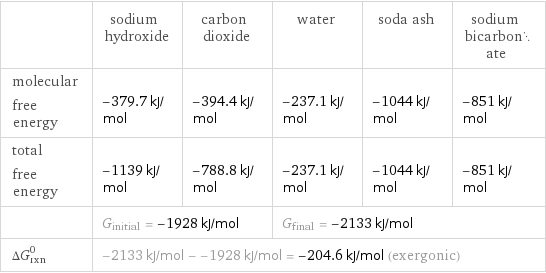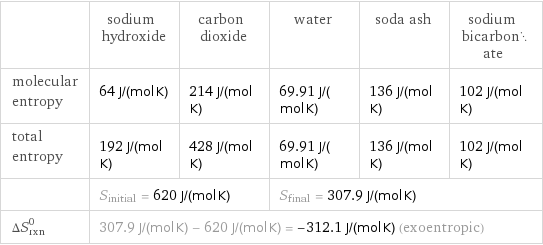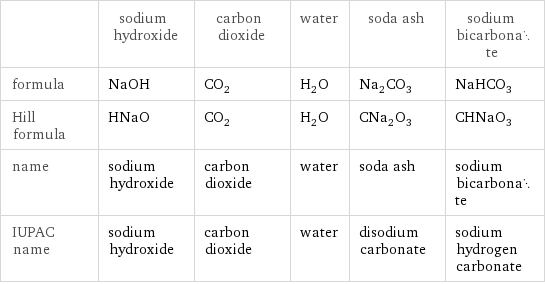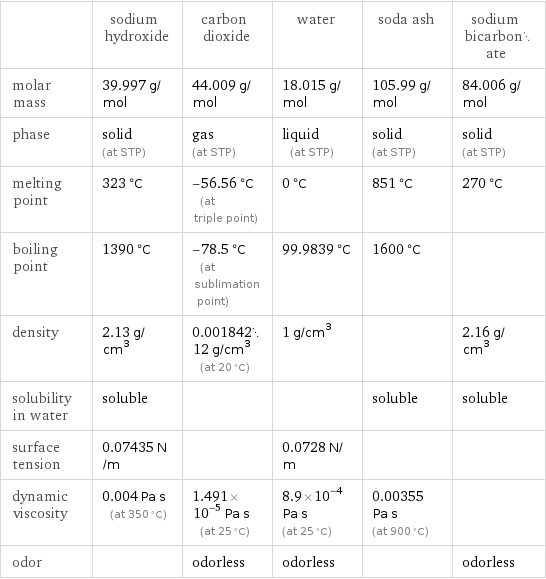Input interpretation

NaOH sodium hydroxide + CO_2 carbon dioxide ⟶ H_2O water + Na_2CO_3 soda ash + NaHCO_3 sodium bicarbonate
Balanced equation

Balance the chemical equation algebraically: NaOH + CO_2 ⟶ H_2O + Na_2CO_3 + NaHCO_3 Add stoichiometric coefficients, c_i, to the reactants and products: c_1 NaOH + c_2 CO_2 ⟶ c_3 H_2O + c_4 Na_2CO_3 + c_5 NaHCO_3 Set the number of atoms in the reactants equal to the number of atoms in the products for H, Na, O and C: H: | c_1 = 2 c_3 + c_5 Na: | c_1 = 2 c_4 + c_5 O: | c_1 + 2 c_2 = c_3 + 3 c_4 + 3 c_5 C: | c_2 = c_4 + c_5 Since the coefficients are relative quantities and underdetermined, choose a coefficient to set arbitrarily. To keep the coefficients small, the arbitrary value is ordinarily one. For instance, set c_3 = 1 and solve the system of equations for the remaining coefficients: c_2 = c_1 - 1 c_3 = 1 c_4 = 1 c_5 = c_1 - 2 The resulting system of equations is still underdetermined, so an additional coefficient must be set arbitrarily. Set c_1 = 3 and solve for the remaining coefficients: c_1 = 3 c_2 = 2 c_3 = 1 c_4 = 1 c_5 = 1 Substitute the coefficients into the chemical reaction to obtain the balanced equation: Answer: | | 3 NaOH + 2 CO_2 ⟶ H_2O + Na_2CO_3 + NaHCO_3
Structures

+ ⟶ + +
Names

sodium hydroxide + carbon dioxide ⟶ water + soda ash + sodium bicarbonate
Reaction thermodynamics
Enthalpy

| sodium hydroxide | carbon dioxide | water | soda ash | sodium bicarbonate molecular enthalpy | -425.8 kJ/mol | -393.5 kJ/mol | -285.8 kJ/mol | -1131 kJ/mol | -950.8 kJ/mol total enthalpy | -1277 kJ/mol | -787 kJ/mol | -285.8 kJ/mol | -1131 kJ/mol | -950.8 kJ/mol | H_initial = -2064 kJ/mol | | H_final = -2367 kJ/mol | | ΔH_rxn^0 | -2367 kJ/mol - -2064 kJ/mol = -302.9 kJ/mol (exothermic) | | | |
Gibbs free energy

| sodium hydroxide | carbon dioxide | water | soda ash | sodium bicarbonate molecular free energy | -379.7 kJ/mol | -394.4 kJ/mol | -237.1 kJ/mol | -1044 kJ/mol | -851 kJ/mol total free energy | -1139 kJ/mol | -788.8 kJ/mol | -237.1 kJ/mol | -1044 kJ/mol | -851 kJ/mol | G_initial = -1928 kJ/mol | | G_final = -2133 kJ/mol | | ΔG_rxn^0 | -2133 kJ/mol - -1928 kJ/mol = -204.6 kJ/mol (exergonic) | | | |
Entropy

| sodium hydroxide | carbon dioxide | water | soda ash | sodium bicarbonate molecular entropy | 64 J/(mol K) | 214 J/(mol K) | 69.91 J/(mol K) | 136 J/(mol K) | 102 J/(mol K) total entropy | 192 J/(mol K) | 428 J/(mol K) | 69.91 J/(mol K) | 136 J/(mol K) | 102 J/(mol K) | S_initial = 620 J/(mol K) | | S_final = 307.9 J/(mol K) | | ΔS_rxn^0 | 307.9 J/(mol K) - 620 J/(mol K) = -312.1 J/(mol K) (exoentropic) | | | |
Equilibrium constant
![Construct the equilibrium constant, K, expression for: NaOH + CO_2 ⟶ H_2O + Na_2CO_3 + NaHCO_3 Plan: • Balance the chemical equation. • Determine the stoichiometric numbers. • Assemble the activity expression for each chemical species. • Use the activity expressions to build the equilibrium constant expression. Write the balanced chemical equation: 3 NaOH + 2 CO_2 ⟶ H_2O + Na_2CO_3 + NaHCO_3 Assign stoichiometric numbers, ν_i, using the stoichiometric coefficients, c_i, from the balanced chemical equation in the following manner: ν_i = -c_i for reactants and ν_i = c_i for products: chemical species | c_i | ν_i NaOH | 3 | -3 CO_2 | 2 | -2 H_2O | 1 | 1 Na_2CO_3 | 1 | 1 NaHCO_3 | 1 | 1 Assemble the activity expressions accounting for the state of matter and ν_i: chemical species | c_i | ν_i | activity expression NaOH | 3 | -3 | ([NaOH])^(-3) CO_2 | 2 | -2 | ([CO2])^(-2) H_2O | 1 | 1 | [H2O] Na_2CO_3 | 1 | 1 | [Na2CO3] NaHCO_3 | 1 | 1 | [NaHCO3] The equilibrium constant symbol in the concentration basis is: K_c Mulitply the activity expressions to arrive at the K_c expression: Answer: | | K_c = ([NaOH])^(-3) ([CO2])^(-2) [H2O] [Na2CO3] [NaHCO3] = ([H2O] [Na2CO3] [NaHCO3])/(([NaOH])^3 ([CO2])^2)](../image_source/6db673a7931a81baf071cc75e0baee80.png)
Construct the equilibrium constant, K, expression for: NaOH + CO_2 ⟶ H_2O + Na_2CO_3 + NaHCO_3 Plan: • Balance the chemical equation. • Determine the stoichiometric numbers. • Assemble the activity expression for each chemical species. • Use the activity expressions to build the equilibrium constant expression. Write the balanced chemical equation: 3 NaOH + 2 CO_2 ⟶ H_2O + Na_2CO_3 + NaHCO_3 Assign stoichiometric numbers, ν_i, using the stoichiometric coefficients, c_i, from the balanced chemical equation in the following manner: ν_i = -c_i for reactants and ν_i = c_i for products: chemical species | c_i | ν_i NaOH | 3 | -3 CO_2 | 2 | -2 H_2O | 1 | 1 Na_2CO_3 | 1 | 1 NaHCO_3 | 1 | 1 Assemble the activity expressions accounting for the state of matter and ν_i: chemical species | c_i | ν_i | activity expression NaOH | 3 | -3 | ([NaOH])^(-3) CO_2 | 2 | -2 | ([CO2])^(-2) H_2O | 1 | 1 | [H2O] Na_2CO_3 | 1 | 1 | [Na2CO3] NaHCO_3 | 1 | 1 | [NaHCO3] The equilibrium constant symbol in the concentration basis is: K_c Mulitply the activity expressions to arrive at the K_c expression: Answer: | | K_c = ([NaOH])^(-3) ([CO2])^(-2) [H2O] [Na2CO3] [NaHCO3] = ([H2O] [Na2CO3] [NaHCO3])/(([NaOH])^3 ([CO2])^2)
Rate of reaction
![Construct the rate of reaction expression for: NaOH + CO_2 ⟶ H_2O + Na_2CO_3 + NaHCO_3 Plan: • Balance the chemical equation. • Determine the stoichiometric numbers. • Assemble the rate term for each chemical species. • Write the rate of reaction expression. Write the balanced chemical equation: 3 NaOH + 2 CO_2 ⟶ H_2O + Na_2CO_3 + NaHCO_3 Assign stoichiometric numbers, ν_i, using the stoichiometric coefficients, c_i, from the balanced chemical equation in the following manner: ν_i = -c_i for reactants and ν_i = c_i for products: chemical species | c_i | ν_i NaOH | 3 | -3 CO_2 | 2 | -2 H_2O | 1 | 1 Na_2CO_3 | 1 | 1 NaHCO_3 | 1 | 1 The rate term for each chemical species, B_i, is 1/ν_i(Δ[B_i])/(Δt) where [B_i] is the amount concentration and t is time: chemical species | c_i | ν_i | rate term NaOH | 3 | -3 | -1/3 (Δ[NaOH])/(Δt) CO_2 | 2 | -2 | -1/2 (Δ[CO2])/(Δt) H_2O | 1 | 1 | (Δ[H2O])/(Δt) Na_2CO_3 | 1 | 1 | (Δ[Na2CO3])/(Δt) NaHCO_3 | 1 | 1 | (Δ[NaHCO3])/(Δt) (for infinitesimal rate of change, replace Δ with d) Set the rate terms equal to each other to arrive at the rate expression: Answer: | | rate = -1/3 (Δ[NaOH])/(Δt) = -1/2 (Δ[CO2])/(Δt) = (Δ[H2O])/(Δt) = (Δ[Na2CO3])/(Δt) = (Δ[NaHCO3])/(Δt) (assuming constant volume and no accumulation of intermediates or side products)](../image_source/9ebdbcf506e834efca4ad3a82e72689e.png)
Construct the rate of reaction expression for: NaOH + CO_2 ⟶ H_2O + Na_2CO_3 + NaHCO_3 Plan: • Balance the chemical equation. • Determine the stoichiometric numbers. • Assemble the rate term for each chemical species. • Write the rate of reaction expression. Write the balanced chemical equation: 3 NaOH + 2 CO_2 ⟶ H_2O + Na_2CO_3 + NaHCO_3 Assign stoichiometric numbers, ν_i, using the stoichiometric coefficients, c_i, from the balanced chemical equation in the following manner: ν_i = -c_i for reactants and ν_i = c_i for products: chemical species | c_i | ν_i NaOH | 3 | -3 CO_2 | 2 | -2 H_2O | 1 | 1 Na_2CO_3 | 1 | 1 NaHCO_3 | 1 | 1 The rate term for each chemical species, B_i, is 1/ν_i(Δ[B_i])/(Δt) where [B_i] is the amount concentration and t is time: chemical species | c_i | ν_i | rate term NaOH | 3 | -3 | -1/3 (Δ[NaOH])/(Δt) CO_2 | 2 | -2 | -1/2 (Δ[CO2])/(Δt) H_2O | 1 | 1 | (Δ[H2O])/(Δt) Na_2CO_3 | 1 | 1 | (Δ[Na2CO3])/(Δt) NaHCO_3 | 1 | 1 | (Δ[NaHCO3])/(Δt) (for infinitesimal rate of change, replace Δ with d) Set the rate terms equal to each other to arrive at the rate expression: Answer: | | rate = -1/3 (Δ[NaOH])/(Δt) = -1/2 (Δ[CO2])/(Δt) = (Δ[H2O])/(Δt) = (Δ[Na2CO3])/(Δt) = (Δ[NaHCO3])/(Δt) (assuming constant volume and no accumulation of intermediates or side products)
Chemical names and formulas

| sodium hydroxide | carbon dioxide | water | soda ash | sodium bicarbonate formula | NaOH | CO_2 | H_2O | Na_2CO_3 | NaHCO_3 Hill formula | HNaO | CO_2 | H_2O | CNa_2O_3 | CHNaO_3 name | sodium hydroxide | carbon dioxide | water | soda ash | sodium bicarbonate IUPAC name | sodium hydroxide | carbon dioxide | water | disodium carbonate | sodium hydrogen carbonate
Substance properties

| sodium hydroxide | carbon dioxide | water | soda ash | sodium bicarbonate molar mass | 39.997 g/mol | 44.009 g/mol | 18.015 g/mol | 105.99 g/mol | 84.006 g/mol phase | solid (at STP) | gas (at STP) | liquid (at STP) | solid (at STP) | solid (at STP) melting point | 323 °C | -56.56 °C (at triple point) | 0 °C | 851 °C | 270 °C boiling point | 1390 °C | -78.5 °C (at sublimation point) | 99.9839 °C | 1600 °C | density | 2.13 g/cm^3 | 0.00184212 g/cm^3 (at 20 °C) | 1 g/cm^3 | | 2.16 g/cm^3 solubility in water | soluble | | | soluble | soluble surface tension | 0.07435 N/m | | 0.0728 N/m | | dynamic viscosity | 0.004 Pa s (at 350 °C) | 1.491×10^-5 Pa s (at 25 °C) | 8.9×10^-4 Pa s (at 25 °C) | 0.00355 Pa s (at 900 °C) | odor | | odorless | odorless | | odorless
Units
